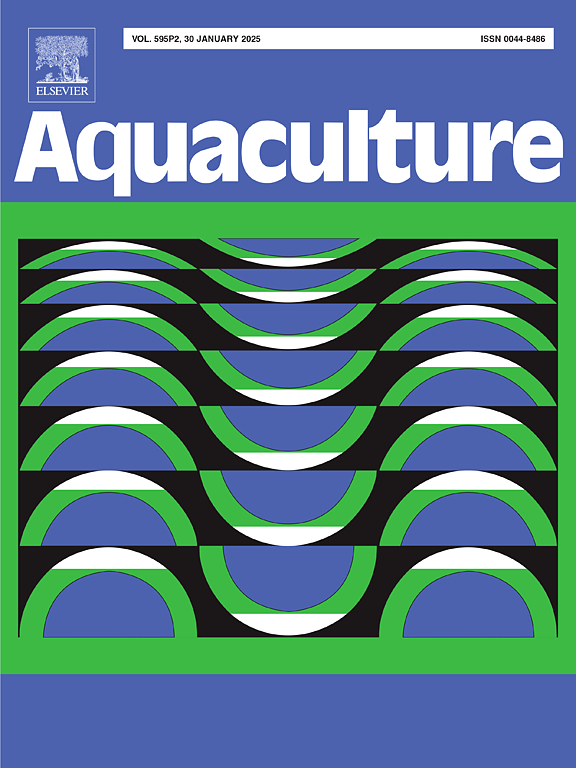Physiological and immunological biomarkers of chronic thermal stress in post-smolt Atlantic salmon, Salmo salar
IF 3.9
1区 农林科学
Q1 FISHERIES
引用次数: 0
Abstract
The increasing prevalence of marine heat waves is a challenge facing global aquaculture, especially for temperate species like Atlantic salmon which, in Australia, are farmed in relatively warm waters. However, we do not understand the mechanistic basis for fish underperformance at temperatures above their thermal optimum and this limits our capacity to develop interventions to offset the effects of warming on production efficiencies. In this study, we compared a diverse suite of physiological and immunological biomarkers in post-smolt Tasmanian Atlantic salmon (∼60–100 g) following 6 weeks of exposure to elevated (19 °C) or optimal rearing temperatures (15 °C). Fish held at 19 °C experienced a significant increase in standard metabolic rate, but no change in maximum metabolic rate which resulted in a significant reduction in factorial aerobic scope. There was a significant increase in upper thermal tolerance limits, but a reduction in hypoxia tolerance in 19 °C-exposed fish. CTmax was also more oxygen-dependent in 19 °C fish suggesting that hypoxia can compound the effects of heat stress on Atlantic salmon. Fish held at 19 °C experienced osmoregulatory disturbances with increase in plasma osmotic pressure, but this was not due to reduced performance of branchial Na+K+ATPase activity. Innate (respiratory burst and white blood cell counts) and adaptive immune responses were also impaired in 19 °C-acclimated salmon. These data demonstrate that the loss of production efficiency in salmon at high temperatures is complex given that multiple physiological systems are impacted simultaneously. Whole animal performance could be improved through the provision of targeted nutritional support to key physiological and/or immune parameters that may be disrupted during periods of thermal stress.
大西洋大马哈鱼幼崽后慢性热应激的生理和免疫生物标志物
日益普遍的海洋热浪是全球水产养殖面临的一个挑战,特别是对温带物种,如大西洋鲑鱼,在澳大利亚,在相对温暖的水域养殖。然而,我们不了解鱼类在温度高于其最佳温度时表现不佳的机制基础,这限制了我们开发干预措施以抵消变暖对生产效率的影响的能力。在这项研究中,我们比较了在升高(19°C)或最佳饲养温度(15°C)下暴露6周后的塔斯马尼亚大西洋鲑鱼(~ 60-100 g)的多种生理和免疫生物标志物。在19°C下饲养的鱼的标准代谢率显著增加,但最大代谢率没有变化,这导致了因子有氧范围的显著减少。在19°c暴露的鱼中,热耐受性上限显著增加,但缺氧耐受性降低。在19°C的鱼类中,CTmax也更依赖氧气,这表明缺氧会加重大西洋鲑鱼的热应激影响。在19°C条件下,鱼体会到渗透调节紊乱,血浆渗透压增加,但这不是由于鳃Na+K+ atp酶活性的降低。先天(呼吸爆发和白细胞计数)和适应性免疫反应也在19°c驯化的鲑鱼中受损。这些数据表明,鲑鱼在高温下的生产效率损失是复杂的,因为多个生理系统同时受到影响。通过对可能在热应激期间被破坏的关键生理和/或免疫参数提供有针对性的营养支持,可以提高全动物的生产性能。
本文章由计算机程序翻译,如有差异,请以英文原文为准。
求助全文
约1分钟内获得全文
求助全文
来源期刊

Aquaculture
农林科学-海洋与淡水生物学
CiteScore
8.60
自引率
17.80%
发文量
1246
审稿时长
56 days
期刊介绍:
Aquaculture is an international journal for the exploration, improvement and management of all freshwater and marine food resources. It publishes novel and innovative research of world-wide interest on farming of aquatic organisms, which includes finfish, mollusks, crustaceans and aquatic plants for human consumption. Research on ornamentals is not a focus of the Journal. Aquaculture only publishes papers with a clear relevance to improving aquaculture practices or a potential application.
 求助内容:
求助内容: 应助结果提醒方式:
应助结果提醒方式:


